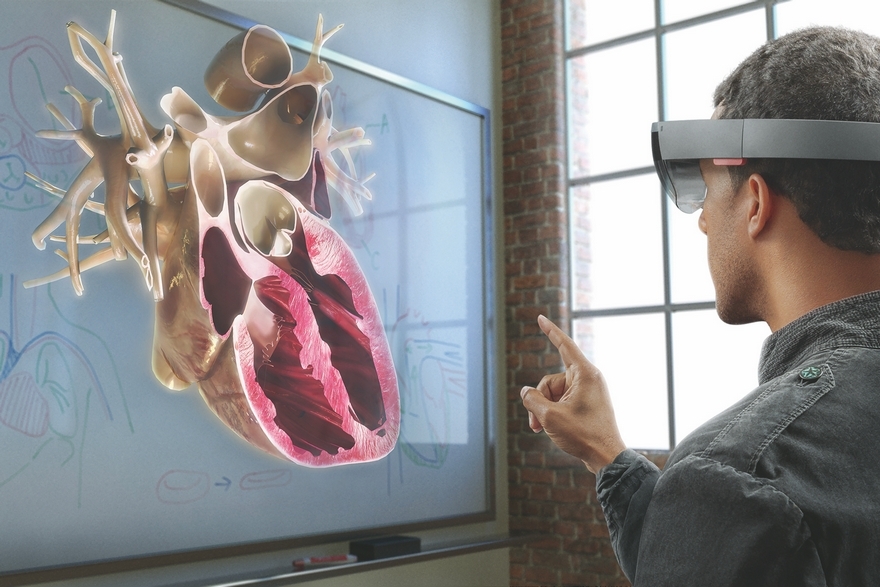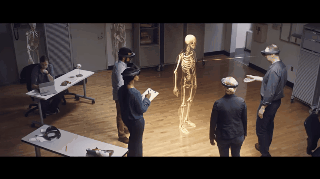Cramming prospective medical students into rooms with cadavers is quickly becoming a thing of the past, thanks to HoloLens. HoloLens, which was created by Microsoft, is the world’s first holographic computer which allows users to interact with 3D holograms anywhere the user wishes. Imagine being a new medical student, it is hard to visualize how different organs interact with each other, or how certain muscles connect to different bones. However, with HoloLens students are now able to recreate a human to actual size and are able to interact with this hologram in anyway the user wants. As stated by HoloLens in their youtube video:
“In gross anatomy we are limited to front facing views of organs, which limits our ability to visualize it in a given system” (0:57).
This cutting-edge technology allows users to learn more about human anatomy than ever imagined. With typical textbooks, students are limited to front or back facing views. When a medical student graduates, this can lead to problems when correctly addressing a patient’s symptoms. With this new virtual reality (VR) technology, students are able to walk around the entire figure, therefore allowing the user to see each organ from every possible angle. HoloLens is equipping new medical students with more knowledge of human anatomy than ever before.

With Holo anatomy, virtual narrators guide the user through learning sessions and the user communicates with the device through speech and movement. This technology allows users to interact with the hologram individually at home, in class, or with large groups of people. HoloLens assess users learning in real time and can create virtual quizzes (i.e. “Please air tap the liver”). According to Microsoft,
“HoloLens understands your gestures, gaze, and voice, enabling you to interact with hologram in the most natural way possible.”
VR with HoloLens allows users to view individual organs, highlight different body system, and can even show one bone at a time. This VR technology offers the user the ability to see a bone in different stages of a break, as illustrated below.

This new technology allows students, or anyone, to learn more about human anatomy. With new VR technology, humans as a whole are better able to communicate, create, collaborate and best of all, explore. If you would like to learn more about VR and how it is changing our world for the better, please check out a link to some of my other blog posts, here and here.
Critique
-
- The assessment and evaluation traits that I selected for this digital story are:
- Project Planning: It was quite evident that a lot of planning went into the production of this video. For example, the video started off by explaining what virtual reality can create with HoloLens and how any person can use the software. There were different pictures, videos, and explanations for why VR with anatomy is creating new medical students. It is also evident the amount of planning that went into creating HoloLens itself.
- Research: There was not a whole lot of research, however, doing a quick web search pulled up lots of information on how VR anatomy is helping a medical student achieve success. The only research related in the video was related to creating virtual quizzes, which is absolutely amazing. The user can choose what they want to be quizzed on or HoloLens will create one for you based off of prior experience.
- Content Understanding: Wow! This video did an amazing job explaining how VR and HoloLens work. It gave a great overview of the many ways that a user can use this software and provided examples within the video of how this software works.
I selected these traits because they were the most relevant to what was presented in the given digital story. I also chose research because I feel like the video could have included more information.
2. Two traits are successfully presented and utilized in the given story because HoloLens is able to share their new technology and ideas with an audience that may not even be related to medical school. The originality of this idea is profound because, in the past, people have had to sign up for expensive anatomy class. Now with VR, anyone who owns HoloLens is able to download the software and explore at their own pace. Microsoft wishes to expand human potential by allowing users to interact with 3D holograms in their own home.
3. This digital story fails to capture what learning is like with users who have previously purchased the product. It would have been nice to actually hear a testimony from someone who has used HoloLens. However, the idea that we may no longer need cadavers is rather unique. VR is now allowing any person, student or not, to explore the world at their own pace and time.
4. Based upon my trait evaluation, this digital story could use more audience engagement by showing a person use the technology, or listening to a person’s testimony about the technology. I will say, I was completely engaged while watching this video because this information is so new and I am excited to see where VR will take humanity in the following years.

One thought on “Saying Goodbye to Cadavers: Virtual Reality with HoloLens”